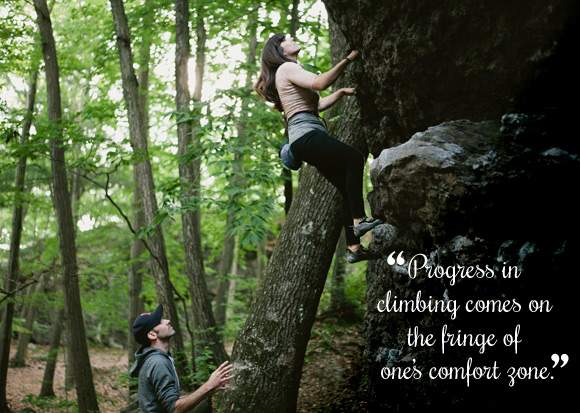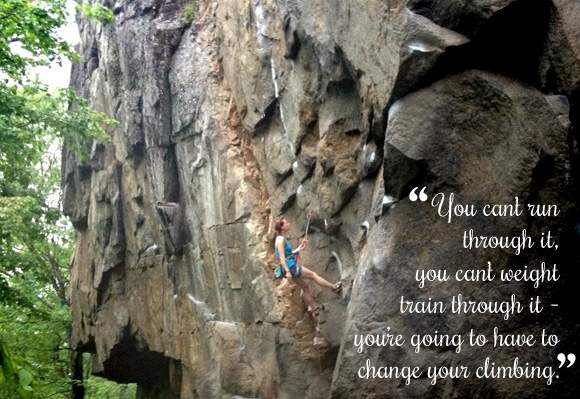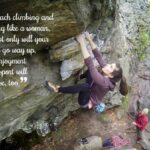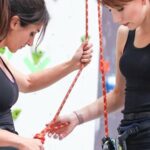3 training questions all climbers should ask; Last week we brought you Three Training Myths for Female Climbers written for us by Steve Bechtel of Climb Strong. Today, Steve is back with three very important training questions climbers should ask themselves. Though they’re geared towards females, these questions definitely apply to guys too! So go ahead and know these 3 training questions: all climbers should ask.

Question #1:
Am I Supporting Or Sabotaging My Progress?
Many times, women get into climbing differently than men do. Almost inevitably, the social situation at the crag ends up being different for women than for men. I’m not saying that one way is better than another, but the structure of a male-as-teacher relationship or an all-girls-day can be as damaging to a female climber’s progress as it is beneficial.
Must-read this informative interview with Tiffany Skogstrom.
Progress in climbing comes on the fringe of one’s comfort zone. Whether it’s a physical difficulty or fear, you get better by addressing these things. Lead more, and get better at leading. Top rope everything and you reinforce the problem. If you’re in a situation where you can always “opt-out” of being uncomfortable, you might be sabotaging your progress.

Male climbers usually avoid these problems. It’s not because they’re somehow “better” than women, either. I think it’s because we’re fundamentally insecure and don’t want to look bad in front of the guys. It’s the same reason we make good soldiers. It’s a useful facet of the otherwise silly machismo most of us possess.
So, how do avoid the trap? Let’s say you are afraid of leading. Even if you boulder V7 and can follow 5.12s, you will want to back you’re leading off to a grade where you feel no problems at all, and then commit to leading 80% of the routes you try. Since your fear is a fundamentally weak link in your performance, you should address it head-on, all the time, until it’s no longer the weak link. I promise that going out and leading a half-dozen easier routes will feel more empowering to you than accepting a top-rope belay on a hard route you know you could lead. Continuing with the topic; 3 training questions all climbers should ask.

Question #2:
Am I Eating To Maximize My Performance?
Eating right for performance and health is critical to any athlete that wants to advance. Somehow, figuring out what to eat just seems to get harder and harder. When it comes to climbers, we have two primary considerations: eating for performance and eating to maintain a lean body.
When it comes to female climbers, the most important nutritional consideration we’ve found is maintaining a consistent energy level on training days. This means avoiding highly refined foods (which pack loads of sugar), even during training. Look for energy from fruits and vegetables, and aim for a minimum of 15 grams of protein each meal, including breakfast. Post-workout bars and shakes are mostly a scam; you can get pretty much everything you need to recover if you just make sure and eat something within an hour of the end of a hard training session.
Staying lean should follow the same general rules. Stay away from the refined stuff. Avoid eating out. Don’t eat late. Hydrate with water. I am a huge fan of Michael Pollan’s Food Rules. It’s a great way to stay on track with your eating and can help you avoid the inevitable failures associated with a radical fad diet plan. The way you’re going to succeed is to look for small changes that result in no more than 1% body weight loss per week. That way you’re not starving and you can still climb hard. Let’s continue to the last one of 3 training questions all climbers should ask.

Question #3:
Am I Plateauing?
Plateauing – getting stuck at the same performance level – is just a part of being an athlete. Climbing is a skill sport, so it’s rare to break a plateau without addressing skills. You can’t run through it, you can’t weight train through it – you’re going to have to change your climbing. Below are the top 5 plateau-breaking strategies:
Travel
Getting away from your local crag or gym can do wonders for your training. If you live near a granite area, beat it for Red Rocks or Rifle. If you boulder in the Southeast, head north for a few weeks and get on some granite. Change of rock type, angle, length of climbs, etc. can really be a game-changer, and you don’t even have to work at it. Your body will make all the adaptations, and you can just have fun seeing a new area.
Chunk It Down
This means breaking your climbing down into its fundamental parts to see where the weak links are. Get on the hangboard and make sure all your hold positions are up to par. How strong is your back? Can you do a single-leg squat? How is your turn-out, and your shoulder flexibility? Test your anaerobic endurance and aerobic endurance. If there is a glaring gap in your strength, the whole machine comes to a stop.
Project
If you’ve never projected a route, you should. Although I’m against year-round projecting (especially climbers trying to bust the “cusp” grades like 12a, 13a…), I think there is a great education to be had by trying one climb over and over for a while. You’ll learn a lot about resting, pacing, mental preparation, and disappointment. By reaching slightly outside your comfort zone, you can really see some big strides forward.
Quit While You’re Ahead
We love the romance of a hard training session, but training too hard is worse than not training at all. If you push too hard in a training session you risk an extended recovery period that doesn’t allow for a normal adaptation. If your sessions are so hard it takes you three days to fully recover, guess what? You lost the value of the training session altogether. For more effective sessions, plan on training for less than an hour at a time, but do more sessions each week.
When you start to see your strength decline in a session, hit the brakes and go home. You have done all you can to get stronger at that point.
Boulder More, Or Start ARCing
If you train in a rock gym, chances are you gravitate toward the routes or problems that suit you. I know I’m making a broad generalization here, but dudes tend to gravitate toward steep routes with big moves and many women tend to stay on the less-steep problems. What matters here is recognizing what your default is, and then changing it. If you’ve never done ARC training (aerobic restoration and capillarity) you probably should. These sessions are long, linked traverses or climbing up and down the wall for 10+ minutes per set.
On the flip side, if you tend to avoid steep climbing, you’re going to see great benefits from jumping into it full speed. By immersing yourself in a whole new style of movement, you’ll see much bigger gains than you would by eeking your strengths forward. Continuing with the topic; 3 training questions all climbers should ask.
A Final Word From Steve
As the sport of climbing advances, the gender gap continues to decrease. Women are redpointing very close to the levels of the top men. and Speed records are getting closer and closer. In the alpine world, the gap is even closer. By training smart and making minor adjustments, there is no reason that women can’t close the gender gap altogether.
Steve, thank you again for contributing to Crux Crush! Be sure to visit climbstong.com for great articles and training advice.
More About The Man Who’s Asking All The Right Questions
Steve Bechtel is a nutrition expert, performance coach, and personal trainer. He graduated from the University of Wyoming in 1995 with a degree in Exercise Physiology. He has been working with athletes of all levels for over fifteen years and is a sought-after expert in training for rock climbing and alpinism. He is a Certified Strength and Conditioning Specialist (CSCS), and is a certified coach with USA Cycling, USA Weightlifting, Kettlebell Athletics, and USA Triathlon. Steve is also a well-known adventure rock climber.
Over the past 27 years, he has made nearly 300 first ascents on 6 continents and has been to the top of some of the world’s hardest big wall-free climbs. The founder of Climb Strong, a training resource for rock climbers, Steve has authored dozens of articles on training and has published three books. He is the co-founder (with his wife, Ellen) of Elemental Performance + Fitness, a full-service training center and climbing gym in Lander, Wyoming.






